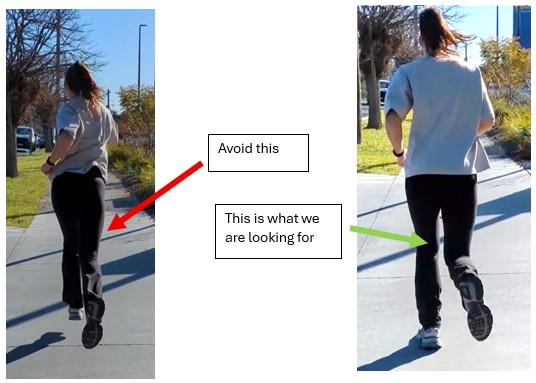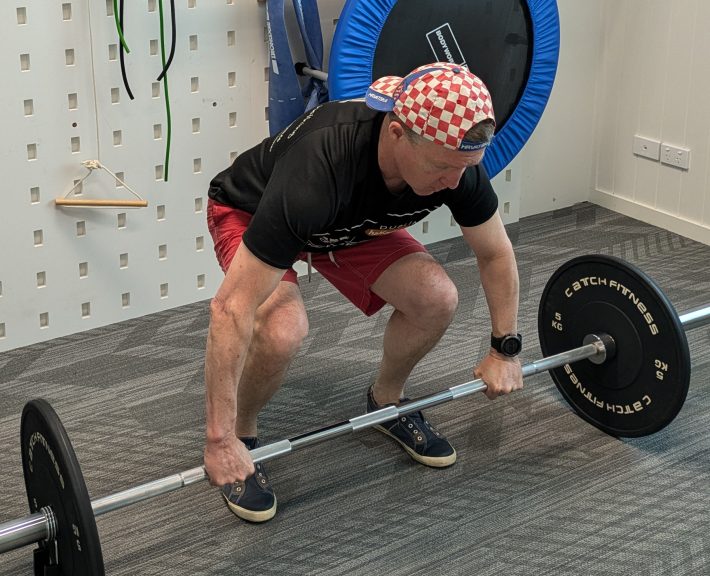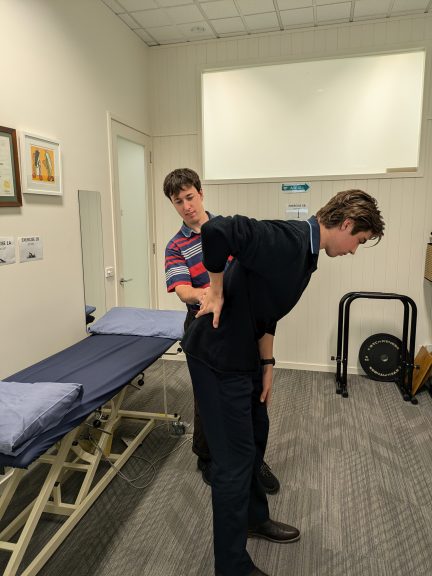Heading into Spring is the perfect time to kickstart your running journey.
Recreational running is one of the most accessible forms of exercise, but just because it is simple does not mean it is easy on your body. How you run, your running mechanics, can determine whether you progress smoothly or end up sidelined with an injury. Good technique is not just for elite athletes. It is important at every level.
Whether you are aiming to prevent injury, improve performance, or just enjoy pain-free runs, understanding your running form is key.
Key Running Mechanics to Know
1. Cadence and Stride Length
Cadence refers to the number of steps you take per minute. Runners who have a lower cadence, i.e., less steps per minute may tend to overstride. This increases the forces on your joints and shifts your foot strike ahead of your centre of mass (refer to the runner on the right, who has high impact going through their hip, knee and ankle).1,2, Increasing your cadence slightly (by even 5-10 steps/min) could help to prevent these things from occurring;1 this is one of the simplest ways to reduce injury risk and prevent shin pain or knee overload.1,2,3
2. Arm Swing Improves Efficiency
Your arms can have an influence on your rhythm, stability and efficiency. To maximise your running efficacy, keep your elbows bent at around 90°, drive your arms backwards (not across your body), and let the movement come from your shoulders.4 A relaxed, symmetrical arm swing helps counterbalance leg movement and stabilise your trunk.4
3. Forward Torso Lean
There should be subtle forward lean from the waist and ankles with the direction of movement.5 Think of it as “leaning forward” as you run. This forward lean allows you to drive more efficiently with your hip flexors, which is one of the powerhouse muscles for running. Excessive upright posture or backward lean can increase ground contact time, reduce running efficiency and can increase forces through your spine, resulting in lower back pain.5
4. Foot Strike Matters
Foot strike is often debated, but what is more important is how and where your foot lands.1,6 While midfoot or forefoot striking is often encouraged, especially to avoid harsh heel strikes that occur with overstriding, there is no single ideal strike pattern for everyone.1,6 A heavy heel strike, particularly if your foot lands far ahead of your hips, can increase forces on your joints.1,6 Aim to land with your foot closer to your centre of mass and avoid excessive reaching, regardless of your foot strike style. Transitioning strike patterns should be done gradually paying attention to strength and control.
5. Avoid crossing legs over when running (i.e. scissoring)
Another common running issue that can be addressed, is “scissoring”, where the legs cross over the midline of the body during foot strike.1,2,7 This can reduce running efficiency and increase strain on the knees, hips, and iliotibial bands (ITB – the band of muscle than runs down the side of your thigh) causing discomfort/tightness. It is often linked to weak glute muscles or poor core control.1,2,7 To correct this, focus on slightly widening your stance, strengthening your glutes and core, and increasing cadence.1,2,7 Improving this aspect of running form can enhance stability, reduce injury risk, and lead to a more efficient, powerful stride.

6. Pelvic Control Matters
Your pelvis is the bridge between your upper and lower body, so how it moves during running is very important.8 A pelvic drop (one side of the pelvis dipping when the opposite leg is in stance) can stem from reduced pelvic stability which can be linked to weak glutes.8 This can cause knee misalignment, ITB syndrome, or hip pain.7,8 Excessive pelvic rotation, i.e., where the pelvis twists too much with each step, may be associated with limited hip flexor length, weak core stabilisers, or hip joint instability. Both patterns can be inefficient, slow you down, and increase injury risk.7,8
To address this, focus on glute and core strengthening, check your hip flexibility, and aim for a smooth, controlled pelvic position with minimal side drop or excessive rotation.7,8
| Do's ✅ | Don'ts ❌ |
| Keep elbows at around 90°, swing arms backwards from the shoulder in a relaxed, symmetrical motion | Overstride (foot lands far ahead of your hips) |
| Lean slightly forward from the hips and ankles | Let arms cross your body or stay rigid |
| Land closer to your body regardless of foot strike type | Run completely upright or lean backwards |
| Strengthen calves, glutes, hip flexors and core regularly | Heavy heel strike with foot far in front |
| If trialling barefoot/minimalist running, progress gradually on soft surfaces and monitor body response | Cross legs over midline ("scissoring") |
| Include dynamic warm-ups before runs and stretches after to cool down | Avoid strength training |
| Keep your gaze forward (not down at your feet) to encourage good posture | Drastically change to barefoot running |
Common Injuries from Poor Running Mechanics1,2,9
- Plantar Fasciitis: Often linked to poor load management, weak foot muscles and/or foot structure.
- Achilles or Peroneal Tendinopathy: Can be due to weak calves and/or foot muscles or inefficient push-off mechanics.
- Patellofemoral (Runner’s) Knee Pain: Frequently related to poor knee control and excessive loading.
- ITB Syndrome: Often related to lateral hip weakness, muscle tightness or a sudden increase in load.
Tips to Improve Your Form:
- Film yourself running to spot asymmetries.
- Try running drills (e.g., prancing or high knees) to improve mechanics.
- Resistance training 2–3 times per week, with a particular focus on muscle strength, power and endurance in the hip flexors, glutes and calves.
- Manage your running load by gradually building in distance or speed; start slow.
- Assess your footwear and consider the surface you are running on, as well as your running course; start on firm, flat surfaces and build from there.
- Adjusting your cadence may help to prevent overstriding and narrow running patterns.
- Use your arms. Rhythm and posture start from the top down.
- Maintain a forward lean, it can help to improve your running efficacy.
What about Barefoot Running?
Barefoot running has become a hot topic in recent years, and for good reason. Running without shoes, or in minimalist footwear, can encourage a more natural gait pattern, often increasing cadence, reducing overstriding, and promoting forefoot or midfoot striking.10,11 It may also help strengthen the muscles within your foot, improve your senses and increase feedback from mechanoreceptors in your foot.10,11
However, if you are considering the move to barefoot running, this should be done with caution. Without adequate calf strength and load tolerance, runners are at risk of injuries such as foot stress fractures or Achilles tendinopathy and could increase forces going through your knee, ankle and foot.10,11,12
Your foot shape also plays an important role. Runners with flat feet (low arches) may naturally load more through the inside of the foot and ankle, which can increase compressive loads on the tendons (tibilias posterior, flexor hallucis longus and flexor digitorum longus) on the inside of the ankle and consequently cause an overactivity of the muscles on the outer aspect of the calf (peroneal muscles).13
On the other hand, those with high arches (hollow foot) tend to have less natural shock absorption and may experience higher loading through the forefoot and heel, potentially increasing stress fracture risk in the bones of your foot or heel pain.13
In both cases, barefoot running changes loading patterns significantly, so a gradual approach with targeted strengthening (foot muscles, calves, and hips) is crucial to avoid injury. If you are considering barefoot running, you may need to seek professional guidance first, from a physiotherapist or podiatrist to assess whether to is appropriate for you and your individual needs.
If you are starting out, we would recommend trialling short distances on soft surfaces like grass, bearing in mind that this may be challenging, and gradually build up over several months. A good way to begin barefoot running is by using minimalist shoes first, which offer some protection while still allowing for some natural foot mechanics. As always when starting out, pay close attention to how your body responds and progress gradually.
Want Expert Help?
At Peak MSK Physio, we offer comprehensive running assessments including gait analysis, strength testing, and movement assessments to help you run stronger and smarter. Whether you are training for your first fun run or looking to prevent recurring injuries, or have a pre-existing injury, we can help fine-tune your technique and build a personalised plan to support your goals.
Book your assessment today and unlock your potential.













